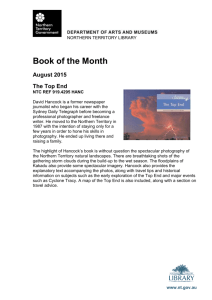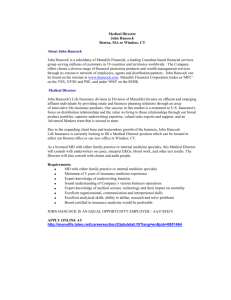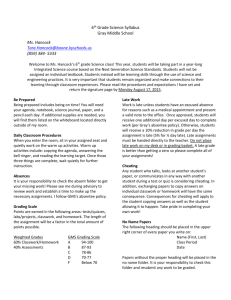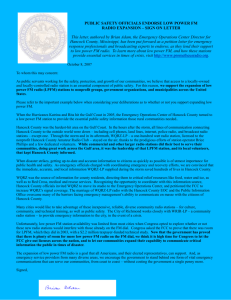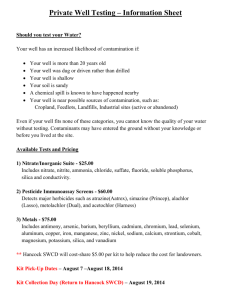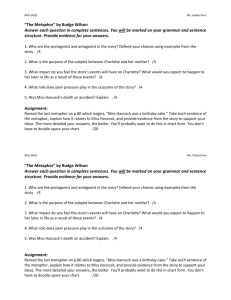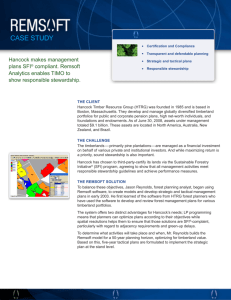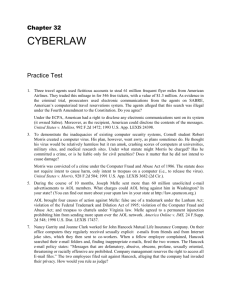The Hancock History in MS Word Document
advertisement
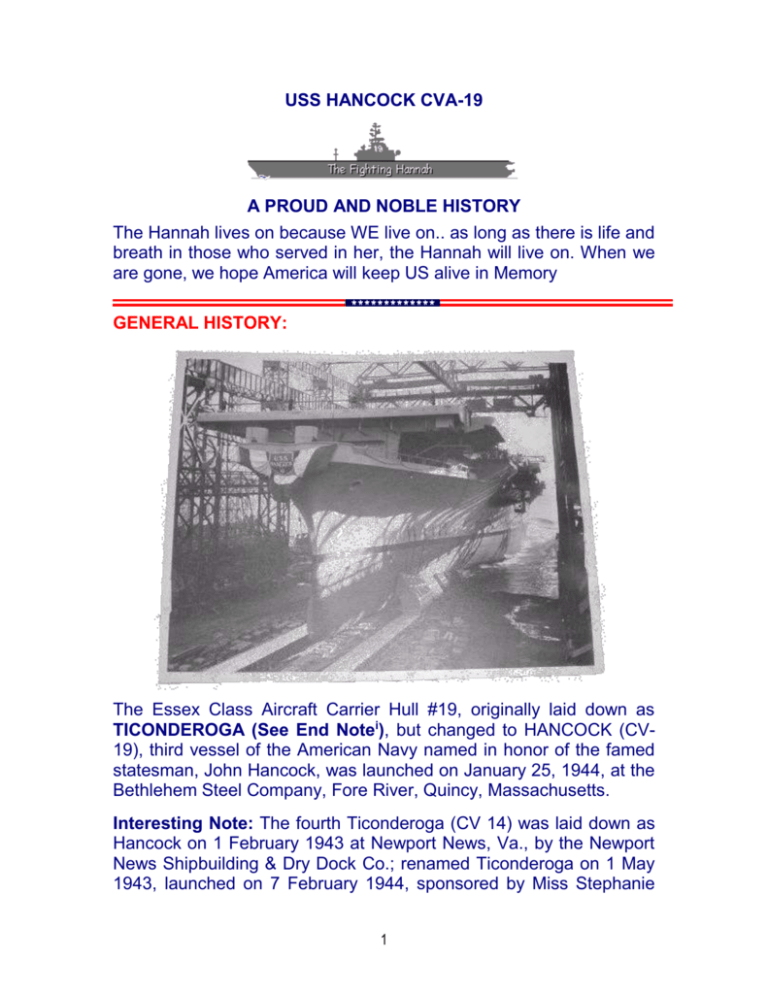
USS HANCOCK CVA-19 A PROUD AND NOBLE HISTORY The Hannah lives on because WE live on.. as long as there is life and breath in those who served in her, the Hannah will live on. When we are gone, we hope America will keep US alive in Memory GENERAL HISTORY: The Essex Class Aircraft Carrier Hull #19, originally laid down as TICONDEROGA (See End Notei), but changed to HANCOCK (CV19), third vessel of the American Navy named in honor of the famed statesman, John Hancock, was launched on January 25, 1944, at the Bethlehem Steel Company, Fore River, Quincy, Massachusetts. Interesting Note: The fourth Ticonderoga (CV 14) was laid down as Hancock on 1 February 1943 at Newport News, Va., by the Newport News Shipbuilding & Dry Dock Co.; renamed Ticonderoga on 1 May 1943, launched on 7 February 1944, sponsored by Miss Stephanie 1 Sarah Pell, and commissioned at the Norfolk Navy Yard on 8 May 1944, Capt. Dixie Kiefer in command. The aircraft carrier USS Hancock (CVA-19), third vessel of the American Navy named in honor of the famed statesman, John Hancock, was launched on January 25, 1944, at the Bethlehem Steel Company, Fore River, Quincy, Massachusetts. Mrs. Dewitt Ramsey, wife of Rear Admiral Ramsey, USN, acted as sponsor for the 27,000 ton carrier. The first ship of the Navy to bear the name Hancock was one of the first group of thirteen frigates authorized for our Continental Navy. This 52 gun ship was named for John Hancock, first signer of the Declaration of Independence. The Hancock, in company with the Boston, captured the British Frigate Fox. A few days later the Hancock was alone and fell in with the HMS Rainbow. After a long chase the Rainbow succeeded in capturing the Hancock. She was renamed the Iris, and as such was known as one of the fastest frigates of her day. The second Hancock was taken over by the Navy from the War Department in 1902. She had various assignments as receiving ship and troop transport. During World War I she was engaged in transporting the American Expeditionary Forces to France. She was stricken from the Navy list in 1925 and sold in 1926.Following her commissioning on 15 April 1944, the present Hancock moved to Port of Spain, Trinidad, B.W.I. for her shakedown then back to Boston, Mass., and then via the Panama Canal headed for the Pacific Theater of Operations. After brief stops at San Diego and Pearl Harbor, the Hancock joined Admiral Halsey's Third Fleet at Ulithi in the Western Carolines. Steaming north and west from Ulithi the fast carrier hit airfields on Okinawa Jima on 10 October, thrusting devastation upon airfields and assembled shipping. Her planes chalked up their first kills in a highly successful sweep which reduced Japanese surface forces by a submarine tender, a large tanker, a medium freighter, one small oiler, one oil barge, one LST, and six luggers. Striking again while the Japanese were off balance, the force swung north through the night to launch strikes against Formosa on Columbus Day. As the sun set over the East China Sea a swarm of almost a hundred Japanese aircraft set upon Task Force 38.2. Two 2 confirmed kills were credited to the Hancock's AA guns in a series of raids which lasted for over seven hours. The Task Force now headed for Ulithi for rest and replenishment. Before they were able to get there, however, the fleet was in motion toward the Philippines and the Battle of Leyte Gulf. The Hancock turned back toward the Philippines but was unable to reach them in time for the opening day fight. Nevertheless, the Hancock's planes caught the retreating Japanese force off the northeast coast of Samar. Attacking again and again the avenging planes scored hits on numerous battleships and cruisers. As the last strike was delivered the central enemy force lay under a heavy pall of its own smoke. Retreating through San Bernardino Strait in the night the enemy found "Hannah's" planes waiting for it as it fled through Jintotola Channel. The force entered the Sibuyan Sea where the battleship Musashi, Bismark of the Japenese Navy, was hit with a 1000 pound bomb. Through this first operation and the second which followed shortly, the Hancock came out unscathed while dealing a hard blow to the enemy. On her third operation the Hancock's accompanying carriers were hit hard, but the Hancock's luck held. The next operation was cut short due to a severe typhoon which prevented refueling and damaged the anti-aircraft cruiser San Juan as well as damaging three destroyers so badly that they foundered with severe loss of life. The next sortie from Ulithi saw the Hancock attacking airfields and shipping from the Philippines to Thailand. This was the first penetration of the South China Sea by our surface forces since the beginning of the war. The Hancock drew her first damage on this operation when a returning torpedo plane blew up on the flight deck adjacent to the island. Tokyo was the target for raids made by Air Group Eighty on 16 February, 1945 when strikes were directed at airfields east of Tokyo and vicinity, resulting in dogfights over the Japanese capital. The record set by Air Group Eighty for that day's operations surpasses the old one set by the Lexington in 1943 at the "Marianas Turkey Shoot." Six strikes from the Hancock's decks knocked seventy-one confirmed enemy planes out of the sky plus eighteen probables and twentyseven damaged. 3 Emphasis by Jake on a very Exciting and Tense moment in Hancock's History During a strike against the home islands of Japan, while the Hancock was refueling the destroyer Halsey Powell, the taskforce was attacked by Kamikaze. An enemy plane was stopped at seven hundred feet overhead by a direct hit but the heavy engine and bomb carried over the starboard side and crashed into the fantail of the Powell. The blow eliminated steering control on the destroyer which immediately sheered to port while the Hancock backed emergency full. From the island Captain Hickey lost sight of the crippled destroyer as she careened across Hancock's bow and under the flight deck overhang. Watchers waited with braced feet for the grinding noise of steel under the momentum of the Hancock's 33,000 tons, but the Powell cleared by inches. In support of the Okinawa invasion, the Hancock was hit by a Japanese plane when he skimmed through heavy fire in a low attack that ended with the enemy cart wheeling across her flight deck into the spotted planes of Air Group Six. His bomb hit the port catapult with a terrific explosion, followed by the blast of pent-up gasoline fumes as tanks burst under the onslaught of the Japanese juggernaut. Many men were blown over the side by the initial explosion while others were forced to jump to the comparative safety of the open sea. Once again Hancock left the formation and fought against destruction. Wheeling in high speed right turns, the skipper attempted to throw three burning planes forward over the side and to dislodge the sixteen planes parked aft. In less the 50 minutes the Hancock was back in action and planes returning from strikes were able to land aboard four hours later. Hancock needed extensive repairs and headed for Pearl Harbor. Repairs completed, the Hancock again headed for Japanese waters, giving Wake Island a severe pounding enroute. A plane from the Hancock shot down the last enemy plane of the war--a torpedo plane diving on a nearby British Task Force. Her scoreboard showed 732 Japanese planes, 17 warships, and 31 merchant vessels destroyed by her Air Groups and 10 planes destroyed by her guns. Three Air Groups had flown from her decks: Seven, Eight, and Six. Listed as killed or missing were 221 shipmates. 4 The Hancock made several cruises after the war, the "Magic Carpet" Operation, bringing the troops home. The Hancock was inactivated in 1946. Recommissioned in 1954, the Hancock was chosen as the first carrier in the U.S. Navy to have steam catapults installed. Equipped with these catapults, the mirror landing system, and angled deck, the Hancock is capable of operating all carrier type planes now in service. In August 1955, the Hancock again deployed to the Far East where she carried on intensive training and flight operations. Returning to her home port at Alameda in September 1957, the Hancock operated off the California coast carrying on an extensive training program. The Hancock's next Far East cruise was made in February 1958. During this cruise she was called upon to patrol the Formosa Straits during the tense Quemoy situation. The ship returned to the United States in October. Again, in August 1959, the Hancock deployed to the Far East, this time in a time of unrest in Laos. Arriving in the Philippines in the latter part of September, the Hancock was made the ready carrier and was kept alert in the area for quite some time before resuming her scheduled deployment in Hong Kong and Japan. She returned home in January 1960. During the 1960-1961 Western Pacific cruise, the Hancock piled up a record that is envied by bigger and newer carriers. Her readiness and capability are attested to by her log of flight hours, and record of drills and exercises. In March of 1961 Hancock returned to Alameda completing her cruise. She steamed to Bremerton, Washington where shipyard workers took over and began the start of a four month $4,000,000 overhaul. December brought another change of command for Hancock, when Captain P.K. Blesh relieved Captain Kelly on the 19th. On February 2, 1962, with Carrier Air Group 21 aboard, she again set sail for far eastern waters, pausing at Pearl Harbor, Hawaii for operational readiness inspection. As flagship for ComCarDivThree, Hancock departed Yokosuka for the South China Sea. During her 5 stay in this tropical climate, she proved her readiness in numerous exercises and in the breakout of strife in Laos, and Viet Nam. * It was at this time that I came aboard as Ships company. You can read about my time on board ship by being piped aboard the USS Hancock (CVA-19) once more and 'Live the Adventure' again with me. On August 23, 1962, the Hancock sailed across San Francisco Bay for six weeks of repairs at the San Francisco Naval Shipyard, Hunters Point. November 28, 1962 saw Captain P.K. Blesh relieved by Captain T.D. Harris in ceremonies aboard the carrier. Hancock set sail for Subic Bay, Philippines to join the Seventh Fleet on June 20, 1963. Note: A Shipmate sent the Yeoman an Email September 1, 2006 asking, "Why are we not mentioning the part the Hannah played in October 1962, during the Cuban Blockade? - John F Davis 19611964 And so I sent the XO a Query regarding this short moment in history, and our XO and Website Historian, Dennis Milliken quickly responded: "No problem on this assignment Jake! You should remember a little about that period! It was about the time when you came aboard. Sadly the Hancock did not play any role, in either event (referring to the Bay of Pigs and the Cuban Missile Blockade).. During the Cuban missile crisis the ship was in dry-dock at Hunter's Point. I was going home on leave when the crisis broke out. When I got to Salt Lake City, Utah, there were military police checking serviceman's leave papers. (Remember you had to travel in Uniform then) Those from the East Coast were turned around. West Coast got to continue home, with instructions to contact or Telegram their duty stations for instructions as to their leave status. I did and waited one day for a response. Leave status unchanged! We did not have the massive news media like we have today, so a quick check with the short Six o’clock national news was a priority every evening while I was home. I do remember it was kind of hard to enjoy that leave. I was on leave for 14 days and the crisis consumed 10 days of it "Ten Days October" 6 and "The Missiles of October" were tittles for books and movies about the events of October 1962. As I mentioned except for major newspapers and limited television news programs, for some, the crisis was over before they knew about it in any detail, except for the East Coast. They were well aware of it! ~ Dennis” After operations off the coast of California, she made a brief cruise in December 1962 to the coast of Hawaii while qualifying pilots which we called our "Pineapple Cruise" then again sailed 7 June 1963 for the Far East, arriving June 20, 1963, Subic Bay, Philippines to join the Seventh Fleet. The following is a brief synopsis of WestPac Cruise '63 as Jake experienced it... Hancock passed her ORI (Operations Readiness Inspection) with flying colors during her three weeks trials in the waters around the islands of Hawaii. Upon satisfactorily completing ORI, she set sail for the waters of the Western Pacific, but first stopping for a brief stay in her WestPac port of Subic Bay, P.I. Here, her crew enjoyed great liberty in port at Cubi Point, Grande Island, Olongapo City and also Manila. On 7 June 1963, Operations saw us begin our 7 month WestPac Cruise in the South China Sea around the waters of South Vietnam. Sometime in November, Hancock received word about troubles in the tiny Southeast Asian country, and while on a two weeks R & R port of call in Hong Kong, was called to steam into the Gulf of Tonkin on emergency orders, participating in Operation "Nightmare" - It was during this time, that President Kennedy and also the puppet president Diem of South Vietnam were assassinated. Hancock and the Nation was entering troubled waters and troubled times, which would not only bring us into the Vietnam conflict, but would keep us in it for a period of over 10 years. The "10,000 Day War" as it has come to be known in History. Hancock was called off it's position as "Southern Carrier" and steamed into the Sea of Japan, to cover for the USS Coral Sea (CVA43), which needed extensive repairs in Pearl Harbor.. with some Port calls in both Yokosuka and Sasebo, Japan. It was here, that the picture you see of me here was taken. 7 Hancock filled the position of "Northern Carrier" until relieved by USS Midway sometime in December. During this time, the crew and ship endured several very dangerous typhoons (Read about that experience in greater depth by reading my Memoirs. Hancock then completed WestPac Cruise '63 in December and steamed back to ConUs but just in time to enjoy a brief stay in Hawaii just before the festive Hawaiian Christmas Holidays.* Synopsis of WestPac '63 was added by Jake from experience and information gleaned from Cruise Book '63 Captain A.J. Brassfield relieved Captain Harris on December 19, 1963 after Hancock returned to the U.S. Since then the 45,000 ton carrier has gone through an extensive yard period. Numerous operations and exercises paved the way for the present Far East cruise. Addendum: Some sad news to report, that after the end of the Vietnam war, Hancock had finally come to the end of her usefulness, and on 30 MAR 76, was decommissioned and stricken from the Navy's List and was scrapped. Hancock enjoyed a 32 year history of Faithful and Honorable service to her country. It is with much sadness, to report this, and although she is no more, she will always remain in our hearts and memories as one of the Navy's Best! The Fight'n Hannah is now only a Memory. * SOURCE: 1964-1965 Log 19 Cruise Book Committee Chairman: Cdr. J.J. Gallegher A US Naval Communication (Orders) was issued when Hancock was completing WestPac '65 and sent out to PIO (Public Information Office), Pacific Fleet, Hawaii..... USS Hancock CVA-19 Press Release - May 15, 1965 US NAVAL COMMUNICATIONS USS HANCOCK CVA 19, PIO, AT SEA 8 THE VETERAN ATTACK AIRCRAFT CARRIER USS HANCOCK WILL ARRIVE AT PEARL HARBOR MAY 17 AFTER SPENDING HER MOST DEMANDING TOUR IN THE FAR EAST SINCE THE SECOND WORLD WAR. DURING THE FIRST THREE MONTHS OF THE CRUISE, HANCOCK WAS BUSY TRAINING, CONDUCTING ROUTINE OPERATIONS WITH THE SEVENTH FLEET AND MAKING GOODWILL VISITS TO VARIOUS FAR EAST PORTS, BUT THIS PATTERN CHANGED. ON SUNDAY MORNING FEB 7 HANCOCK RECEIVED A MESSAGE TO PREPARE HER AIRCRAFT FOR A STRIKE AGAINST NORTH VIET NAM IN RETALIATION FOR THE VIET CONG BOMBING AT PLEIKU. WHEN THE ORDER WAS RECEIVED TO LAUNCH THE STRIKE THE PLANES AND PILOTS OF CARRIER AIR WING 21, COMMANDED BY CMDR. WARREN N. SELLS, WERE READY, HANCOCK'S AIRCRAFT JOINED THOSE OF USS CORAL SEA (CVA-43) ENROUTE TO THE TARGET. THE NAVY AIRCRAFT SUCCESSFULLY STRUCK A VIET CONG STAGING AREA AT DONG HOI, AND SET THE TEMPO FOR FUTURE STRIKES. SINCE THE FEB. 7 STRIKES, "FIGHTING HANNAH" HAS PARTICIPATED IN EIGHT MAJOR STRIKES AND MANY MINOR OPERATIONS IN THE AREA. ON THESE STRIKES HER AIR WING DESTROYED COMMUNIST BILLETING AREAS, HARASSED MOVING TRAFFIC, KNOCKED OUT ANTI-AIRCRAFT BATTERIES, RADAR INSTALLATIONS AND MANY BRIDGES VITAL TO THE COMMUNIST SUPPLY MOVEMENTS. DURING THE CRUISE, THE LONGEST IN-PORT PERIOD FOR HANCOCK WAS NINE DAYS IN SUBIC BAY, P.I. WHILE THE SHORTEST WAS LESS THAN 43 HOURS. HER LONGEST AT SEA PERIOD WAS 36 DAYS OF CONTINUOUS DAY AND NIGHT OPERATIONS IN THE SOUTH CHINA SEA. WHILE IN HAWAIIAN WATERS HANCOCK WILL PARTICIPATE IN NAVAL FIREPOWER OPERATIONS FOR THE JOINT CHIEFS AND A CONFERENCE SPONSORED BY THE SECRETARY OF DEFENSE. HAWAII WILL ALSO BE SCENE OF A MASSIVE SHIPS PARTY FOR THE CREW. 9 THE BLUEJACKETS OF HANCOCK WILL REMEMBER THE 1964'65 CRUISE WITH PRIDE, KNOWING THAT SHE IS THE OLDEST ATTACK AIRCRAFT CARRIER IN THE NAVY, YET HER CREW CAPABLE OF PERFORMING ALL TASKS REQUIRED IN TODAY'S NAVAL WARFARE. THE MIGHTY U.S.S. HANCOCK IS HOMEPORTED IN ALAMEDA, CALIF. OUR MOTTO: “WHEN THE GOING GETS TOUGH, THE TOUGH (HANCOCK) GET GOING” West Pac '67 - '68 Statistical Box Score Anyone having Statistics on Hancock during your 'tenure', please send them to me Deployed 228 Days - 16 June, 1967 To 31 January, 1968 Steamed 92,645 Nautical Miles Launched 15,421 Aircraft Recovered 15,177 Aircraft Flew 9,552 Combat and Combat Support Sorties Dropped 7,500 Tons of Weapons On North Vietnam Flew 181 Major Strikes In Northeast Sector (Critical Sector) Conducted 212 Underway Replenishments Consumed 19,741,749 Gallons Of Black Oil Consumed 11,230,000 Gallons Of Jet Fuel Consumed 974,000 Gallons Of Aviation Gas - 1,398 Combat Awards Recommended - Another History Entry on the Hancock can be found in the Dictionary of American Fighting Ships, Vol. III, 1968, Navy Department, Office of the Chief of Naval Operations, Naval History Division, Washington, 10 D.C. (Next few Pages) ii U.S.S. TICONDEROGA CV-14 - It's interesting to note that HANCOCK was originally laid-down as TICONDEROGA, and the name was on her keel plate, and later changed to HANCOCK. It's also interesting to note that TICONDEROGA was originally laid-down as HANCOCK, text and image courtesy of Wikipedia Online Free Encyclopedia. Please visit the website for more information, or follow links below. The ship was laid down as Hancock on 1 February 1943 at Newport News, Virginia, by the Newport News Shipbuilding & Dry Dock Co.; renamed Ticonderoga on 1 May 1943, launched on 7 February 1944, sponsored by Miss Stephanie Sarah Pell, and commissioned at the Norfolk Navy Yard on 8 May 1944, Captain Dixie Kiefer in command. The name itself refers to the historic Fort Ticonderoga which played a part in early American history. It was to become the lead ship of the Ticonderoga class, though it and other ships of this class are often subsumed into the Essex class carriers. Ticonderoga remained at Norfolk for almost two months outfitting and embarking Air Group 89. On 26 June, the carrier shaped a course for the British West Indies. She conducted air operations and drills en route and reached Port of Spain, Trinidad, on the 30th. For the next 15 days, Ticonderoga trained intensively to weld her air group and crew into an efficient wartime team. She departed the West Indies on 16 July and headed back to Norfolk where she arrived on the 22d. Eight days later, the carrier headed for Panama. She transited the Panama Canal on 4 September and steamed up the coast to San Diego the following day. On the 13th, the carrier moored at San Diego where she loaded provisions, fuel, aviation gas, and an additional 77 planes, as well as the Marine Corps aviation and defense units that went with them. On the 19th she steamed for Hawaii where she arrived five days later. Ticonderoga remained at Pearl Harbor for almost a month. She and Carina (AK-74) conducted experiments in the underway transfer of aviation bombs from cargo ship to aircraft carrier. Following those tests, she conducted air operations - day and night landing and antiaircraft defense drills - until 18 October when she exited Pearl Harbor and headed for the western Pacific. After a brief stop at Eniwetok, Ticonderoga arrived at Ulithi Atoll in the Western Carolines on the 29th. There she embarked Rear Admiral Arthur W. Radford, Commander, Carrier Division 6, and joined Task Force 38 as a unit of Rear Admiral Frederick C. Sherman's Task Group 38.3. 11
